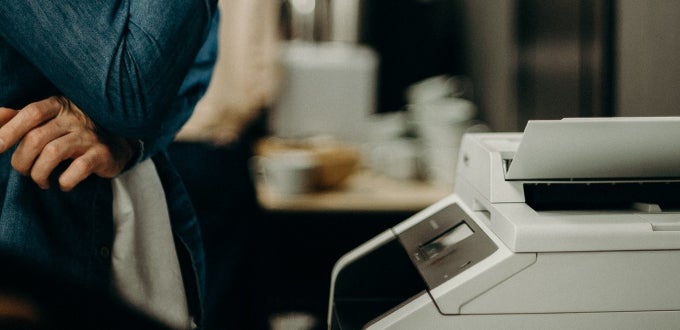You are here
Printing in a Pandemic

In September 2019, there was nearly always a student standing at the Pitt Print stations inside the labs, residence halls, and academic buildings. In offices all around the Pittsburgh campus, the sound of printers was the white noise of a busy department. Heat and the scent of toner emanated from the machines, while documents emerged at a remarkable rate. That fall, students printed over 6.1 million sheets of paper, while Ricoh multifunction devices in Pitt offices processed a whopping 15.5 million sheets. What a difference one year and a global pandemic make. In fall 2020, students printed fewer than 1.5 million and departmental printers spit out fewer than 5.5 million sheets—a reduction of more than two-thirds.
From Constant Whir to Occasional Hum
Some of the impacts of COVID-19 are obvious. Remote classes are conducted over Zoom. Events are held online. Departments, staff, and instructors are contacted electronically. What’s less obvious is the impact of the pandemic on auxiliary services like printing on campus.
The number of students using Pitt Print decreased by over 53% last semester, compared to the typical fall term. That’s not surprising when you think about it. With significantly fewer students on campus and facility restrictions limiting the number of available print locations, reduced printing was to be expected.
More illuminating is how much each on-campus student printed. The average user printed half as much this past fall (125 sheets), compared to fall 2019 (250 sheets). In a normal term, about 1.5% of students exceed their Pitt Print quota; in the fall 2020 term, just 0.3% did so.
Printing habits didn’t just change for students. With most offices closed, most departmental printers went unused. Departments also sent fewer jobs to University Printing Services, resulting in a 73% reduction in postcards, posters, newsletters, flyers, class materials, and other items.
The question Pitt’s Information Technology and Sustainability offices are now exploring is whether changes in printing behavior are likely to continue once things return to a more normal operating posture.
Pandemic Phenomenon or Permanent Habit?
As technology evolved, printing had steadily been decreasing for many years before Covid-19. But the pandemic pushed that trend into overdrive. Instructors accepted assignments and papers electronically, posted editable worksheets that could be completed digitally, and provided class materials that students could download and mark up electronically.
Andrius Petrauskas, a senior civil engineering major who has worked in the Student Computing Labs for four years, has definitely seen a decrease in printing with less in-person activity. “Because everyone is remote, they are turning to online alternatives, instead of printing everything out,” Petrauskas notes. “Students are still printing things like syllabi or lab manuals—things they need to refer to a lot—but they aren’t printing out papers, homework assignments, or readings."
Jacob Beaudway, a freshman neuroscience major, agrees. “I printed out things like lab worksheets and study guides that I wanted to look at while I was connected to my classes. I also printed out things that I wanted to take notes on,” he explained.
Departments have developed digital workflows to accommodate remote operations. The eSignature Service (DocuSign) and Pitt Worx enable online transactions, while Electronic Lab Notebooks (LabArchives) and Microsoft Teams facilitate virtual collaboration. Meanwhile, online calendars, e-newsletters, and social media have been used to publicize events and share information.
Looking Forward
The Office of Sustainability hopes that the digital habits adopted by students, faculty, and staff continue. “Reducing printing positively impacts the University’s sustainability goals. When we reduce printing, we not only use less paper, we also reduce associated chemical and plastic waste from toner and printers,” Aurora Sharrard, director of sustainability, notes.
“We are thankful that the campus community supports our sustainability efforts and are willing to make changes to their habits. Reducing printing—and choosing carbon neutral or 100% recycled content paper when you do print—can be a significant step in that direction,” Sharrard says. Fortunately, Pitt Print Stations already use Tree Zero paper, which is also the cheapest 8.5x11” option for Pitt offices to buy in Panther Express.
Pitt IT expects printing to increase once pandemic restrictions are lifted, but not to its former level. The pandemic has been a crash course on working digitally—and they anticipate it will have a permanent impact. “We’ve built these habits over the course of a whole year, so I think printing will continue to decrease after the pandemic,” Petrauskas predicts.
Whatever way students, faculty, and staff work moving forward, Pitt IT will support the tools they need. “Pitt Print is an important service for our students, and we expect that will always be the case,” says Jeff Rhoades, Technology Help Desk manager. “But it’s also exciting to see the University community utilizing digital alternatives that help them to work more efficiently and effectively. It’s clear that many of the ways we have been using technology during the pandemic will become the norm moving forward.”